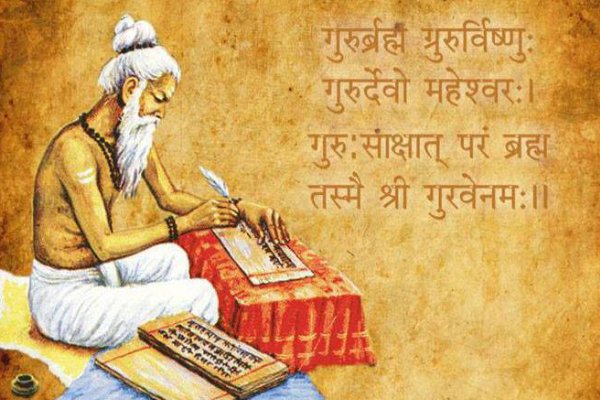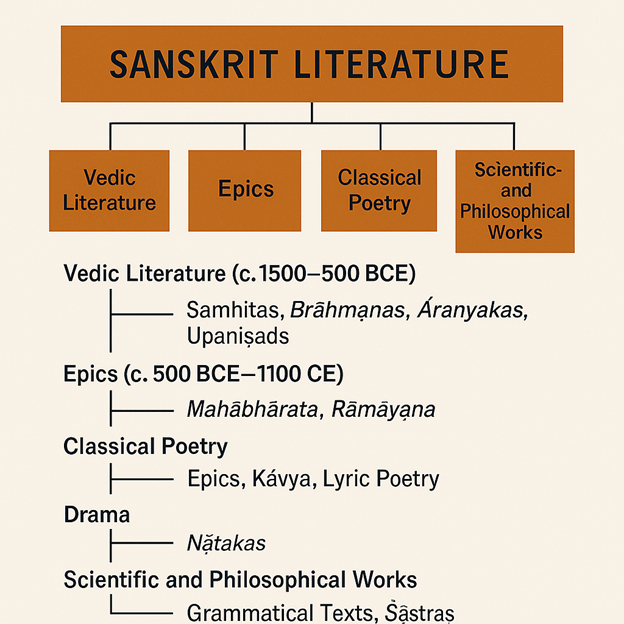Sanskrit Literature
Chronological Classification of Sanskrit Literature
1. Vedic Literature (c. 1500–500 BCE)
- Language: Early Vedic Sanskrit (pre-classical)
- Focus: Rituals, hymns, philosophy, cosmology
- Main Divisions:
- Samhitas: Collections of hymns (e.g., Ṛgveda, Sāmaveda)
- Brāhmaṇas: Prose texts explaining rituals and ceremonies
- Āraṇyakas: Meditative texts for forest-dwelling sages
- Upaniṣads: Philosophical treatises on Brahman, Ātman, and Moksha
- Significance: Religious and philosophical foundation of Hinduism

2. Epic and Classical Period (c. 500 BCE – 1100 CE)
a. Itihāsa (Epics)
- Mahābhārata by Vyāsa:
- Longest epic in the world (100,000 verses)
- Includes the Bhagavad Gītā
- Themes: Dharma, war, family, morality
- Rāmāyaṇa by Vālmīki:
- Story of Lord Rāma, Sītā, and the demon king Rāvaṇa
- Emphasis on dharma, ideal kingship, and devotion
b. Purāṇas (Mythological and Cosmological Texts)
- 18 Mahāpurāṇas and many Upapurāṇas
- Stories of gods, creation, genealogies, and cosmic cycles
- Popular examples: Bhāgavata Purāṇa, Vishnu Purāṇa, Shiva Purāṇa
c. Classical Poetry (Kāvya)
- Mahākāvyas: Epic-style ornate poems
- Raghuvaṃśa and Kumārasambhava by Kālidāsa
- Śiśupālavadha by Māgha
- Lyric poetry: Shorter, more emotional (e.g., Meghadūta)
- Themes: Love, heroism, nature, devotion
d. Drama (Nāṭaka)
- Flourished under Gupta patronage
- Famous dramatists:
- Kālidāsa: Abhijñānaśākuntalam (Recognition of Shakuntalā)
- Bhāsa: Svapnavāsavadattam
- Bhavabhūti: Mālatīmādhava, Uttararāmacarita
- Sanskrit plays blend prose and poetry, and include gods, royalty, and magic.
3. Scientific and Philosophical Literature
- Philosophy (Darśanas):
- Six classical schools: Nyāya, Vaiśeṣika, Sāṅkhya, Yoga, Mīmāṃsā, Vedānta
- Key texts: Nyāya Sūtra, Yoga Sūtra, Brahma Sūtra
- Grammar:
- Pāṇini’s Aṣṭādhyāyī (c. 4th century BCE): A monumental grammar that defines Classical Sanskrit
- Patañjali’s Mahābhāṣya: Commentary on Pāṇini
- Mathematics and Astronomy:
- Works by Āryabhaṭa, Bhāskarācārya, Varāhamihira
- Treatises on algebra, arithmetic, trigonometry, and planetary motion
- Medicine (Āyurveda):
- Caraka Saṃhitā and Suśruta Saṃhitā: Texts on internal medicine and surgery
4. Later Sanskrit (Post-1100 CE to Present)
- Literary production continued, though gradually shifted toward vernaculars
- Emergence of devotional literature (Bhakti movement), commentaries on classical texts
- Sanskrit used in scholarly, ritual, and religious contexts
Thematic Classification of Sanskrit Literature
| Genre | Key Examples | Focus Area |
| Vedic Texts | Ṛgveda, Yajurveda, Upaniṣads | Rituals, hymns, philosophy |
| Epics | Mahābhārata, Rāmāyaṇa | Heroism, Dharma, family, divinity |
| Drama | Abhijñānaśākuntalam, Mālavikāgnimitram | Court life, romance, moral dilemmas |
| Poetry | Meghadūta, Gītagovinda | Emotions, love, devotion, nature |
| Science | Aṣṭādhyāyī, Āryabhaṭīya, Caraka Saṃhitā | Linguistics, astronomy, medicine |
| Philosophy | Brahma Sūtras, Yoga Sūtras, Sāṅkhya Kārikā | Liberation, logic, metaphysics |
| Purāṇas | Bhāgavata Purāṇa, Matsya Purāṇa | Myths, cosmology, devotional tales |
Legacy and Influence
- Linguistic Impact:
- Basis for many modern Indian languages (Hindi, Marathi, Bengali, etc.)
- Influenced Pali, Prakrit, and Tibetan
- Religious Significance:
- Scriptural language of Hinduism, Jainism, and Buddhism
- Used in chants, rituals, temple inscriptions
- Global Recognition:
- Studied worldwide in universities and Indology departments
- UNESCO recognition for oral traditions like Vedic chanting
